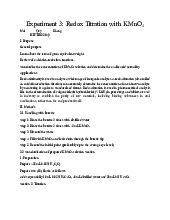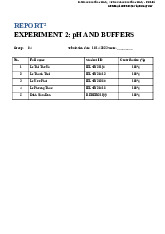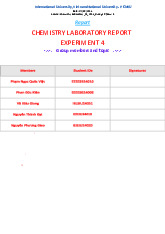



Preview text:
Prelab experiment 1 Mai Quy Khang BTFTIU22049 1. General Purposes:
- To perform different types of chemical reactions, including acid-base, precipitation, gas
forming, complex compound forming and oxidation-reduction reactions.
- To identify the products in these reactions and describe the chemical changes.
- To write and balance the chemical equations for the reactions observed. 2. Methods 2.1 Reaction of Cu2+
Both tubes had 10 drops of CuSO4 per tube.
+ Tube #1 add 10 drops of 2M NaOH mix tube gently and observe the reaction. Put more 10 drops of 2M NaOH.
+ Tube #2 add 10 drops of 2M NH OH 4
mix gently and observe the reaction. Next, put more 10 drops of 2M NH4OH.
Mix both tubes gently and observe the reaction. 2.2 Reaction of Silver halides
Section 1: Reactions of Potassium Chloride (KCl)
Both tubes had 10 drops of 0.5M KCl then add 10 drops of 0.1M AgNO . 3
+ Tube #2 add 10 drops 2M NH4OH.
Mix both tubes gently and wait at least 2 minutes for the reaction.
Section 2: Reactions of Potassium Bromide (KBr)
Both tubes had 10 drops of 0.5M KBr and add 10 drops of 0.1 AgNO . 3
+ Tube #2 add 10 drops of 2M NH4OH.
Mix both tubes gently and wait at least 2 minutes for the reaction. 2.3 Reaction of H2O2
+ Tube #1 had 1 drops of 0.1 KMnO4 then for each in turn add 5 drops of 2M H2SO and 5 4 drops of 3% H2O . 2
+ Tube #2 had 5 drops of 0.1 KI then for each in turn add 5 drops of 2M H 2SO 4 and 5 drops of 3% H2O2.
+ Tube #3 had 10 drops of 3% H2O then add a pinch of MnO 2 2.
Mix all three tubes gently and wait at least 2 minutes for the reaction. 2.4 Reaction of KMnO4
Each tube had 10 drops of 0.5M Na2SO . 3
+ Tube #1 for each in turn add 5 drops of 2M H2SO . 4
+ Tube #2 for each in turn add 5 drops of 6M NaOH.
+ Tube #3 for each in turn add 5 drops of distilled water.
Add all three tubes 5 drops of 0.1 KMnO4 then mix gently and observe the reaction. 2.5 Reaction of Fe2+ and Fe3+ Section 1: Ferric ion (Fe3+)
Per tube had 10 drops of 0.5M FeCl . 3
+ Tube #1 add 5 drops of 2M KOH.
+ Tube #2 add 5 drops of 2M NH4OH
Mix both tubes gently and observe the reaction. Section 2: Ferrous ion (Fe2+)
Per tube got 10 drops of 0.5M FeSO . 4
+ Tube #1 add 5 drops of 2M KOH.
+ Tube #2 add 5 drops of 2M NH4OH.
Mix both tubes gently and observe the reaction. 2.6 Reactions of Al3+
Each tube had 10 drops of 0.5M Al2(SO4) then add 5 drops of 2M NaOH mix gently and observe 3 the reaction.
+ Add 20 drops of 2M HCl to tube #1.
+ Add 20 drops of 2M NaOH to tube #2.
Mix both tubes gently and observe the reaction. 2.7 Flame tests
Step 1: Light the Bunsen burner.
Step 2: Clean the loop with distilled water.
Step 3: Dip the loop into the tested solution. Step 4: Hold it in the flame.
Step 5: Record the dominant flame color. 3. Safety Precautions Copper sulfate (CuSO )
4 is strongly corrosive. If absorbed through skin or eyes, copper sulfate
(CuSO4) can cause burning, stinging sensation. This can lead to itching, inflammation, eczema, conjunctivitis...
Therefore, when using copper sulfate (CuSO ), 4
we need to strictly follow the regulations on
dosage and process. Prepare protective equipment and tools for contact.
In case of slight skin contact, rinse the area exposed to chemicals under water for 10-15 minutes
to completely remove the copper. 4. Suggestion questions 1. Purposes:
- To perform different types of chemical reactions, including acid-base, precipitation, gas
forming, complex compound forming and oxidation-reduction reactions.
- To identify the products in these reactions and describe the chemical changes.
- To write and balance the chemical equations for the reactions observed.
2. A chemical reaction is any transformation from one set of chemicals into another set.
3. Different types of chemicals reaction: synthesis reaction, decomposition reaction, single and
double displacement reaction, combustion reaction.
4. When chemical reactions occur, observable signs are acid-base, precipitation, gas forming,
complex compound forming and oxidation-reduction reactions.
5. Synthesis reaction is a reaction in which two or more reactants chemically bond and combine to form a product. Ex: 2Na + Cl 2 2NaCl
6. Decomposition reaction can be defined as a chemical reaction in which one reactant breaks
down into two or more products. Ex: H 2CO 3 H2O + CO 2
7. Single displacement reaction is the one wherein the atom or a set of atoms is displaced by another atom in a molecule. Ex: Cl + 2NaBr 2 2NaCl + Br2
8. Double displacement reaction is a type of chemical reaction in which positive and negative
radicals of two reactants are exchanged which will lead to the formation of the product. Ex: NaOH + HCl NaCl + H O 2
9. Combustion reaction is a chemical reaction in which a fuel undergoes oxidation by reacting
with an oxidising agent, resulting in the release of energy. Ex: CH + O 4 2 2H2O + CO 2
10. All of the experiments: reaction of Cu2+, silver halides, H 2+ 3+ 3+ 2O2, KmnO , Fe 4 and Fe , Al
11. The molality of a solution is equal to the moles of solute divided by the mass of solvent in kilograms.
The molarity of a solution is equal to the moles of solute divided by the volume of solution in liters.
12. The equation: C = x
C is the speed of light (3 x 108 m/s) is the wavelength (nm)
v is the speed of an electromagnetic wave




